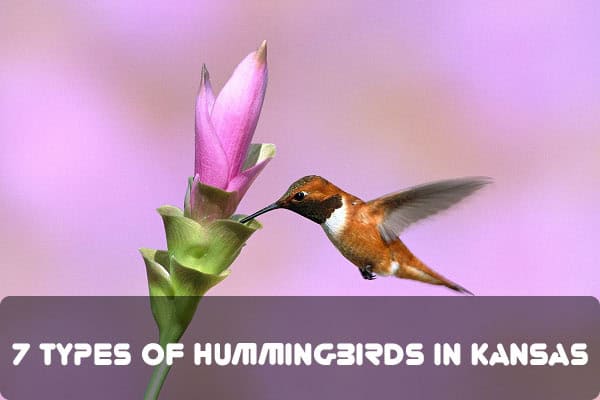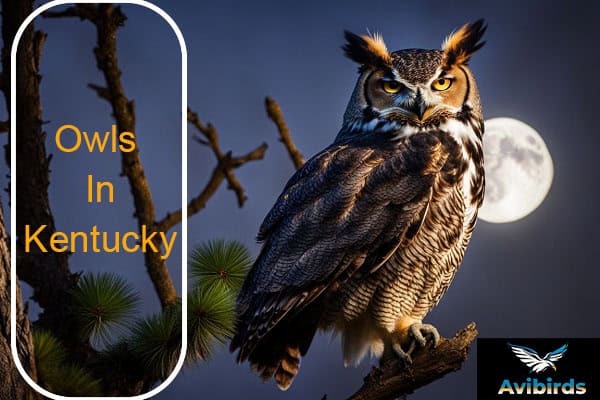Spotting 11 Types Of Finches In Hawaii (Incl. Photos)
Ever wondered about the finches in Hawaii? This place is a dream for bird lovers, with almost 280 species, including many finches or honeycreepers. These small birds live in Hawaii’s remote forests, each one adapted to eat nectar or insects. Sadly, many of these finches are in danger from invasive species and losing their homes. Let’s dive into the 16 types of finches in Hawaii and where to see them.
1. Akekee
- Scientific name – Loxops caeruleirostris
- Lifespan – Unknown
- Size (average) – 3.9 in (10 cm)
- Weight – Unknown
- Wingspan – Unknown
The Akekee is a small, critically endangered honeycreeper found only on Kauai. It lives high up in the Ohia trees of Kauai’s high-altitude ecosystems. Since 2000, its population has dropped by 98%. Now, it urgently needs conservation to survive.
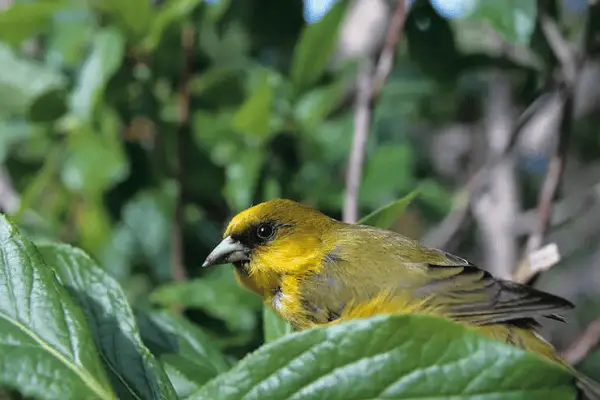
Physical Description and Behavior
The male Akekee has a bright greenish upper body and yellow underparts. His bright yellow head sports a small black face mask. Females are similar but less colorful. They both have a unique crossed beak for eating nectar and insects.
They make a sweet “suweet” call and a trill song in the forest. This song fills the air, showing their presence.
Habitat and Best Locations to Spot
The Akekee lives in Kauai’s high-elevation forests. These forests are filled with Ohia, Koa, Olapa, and Lapalapa trees, above 3,600 feet. The best places to see them are in Koke’e State Park and the Alaka’i Wilderness Preserve on the Alaka’i Plateau.
This species is critically endangered and its numbers are falling. It desperately needs conservation to keep going.
“The most recent estimate for the number of ‘Akekee is 450 birds, give or take fifty.”
2. Akiapolaau
- Scientific name – Hemignathus wilsoni
- Lifespan – 13 years (maximum recorded)
- Size (average) – (14 cm)
- Weight (average) – (28.3 g)
- Wingspan – (18 to 20 cm)
The Akiapolaau is a unique bird found only on Hawaii Island. It has a special beak and eats insects. This makes it a key part of the island’s ecosystem.

The male Akiapolaau has a greenish-yellow back and belly, with a black face mask. The female has an olive back and grayish-yellow belly. Both have a unique bill, perfect for eating insects.
This akiapolaau finch makes beautiful sounds in Hawaii’s forests. It sings “chuw-ee” or “teedle-oo”. It breeds all year, but most in February to July. It makes its nest in ohia trees.
These Akiapolaau finches of Hawaii eat many insects, larvae, spiders, and sap. Its special beak helps it find food in the forest. This helps keep the island’s plants and animals balanced.
There are only about 1,900 Akiapolaau left, and their numbers are going down. They face threats like losing their homes, diseases, and predators. Conservation efforts are trying to save this Hawaii island endemic species.
“The Akiapolaau is a true marvel of evolutionary adaptation, its specialized beak a testament to the incredible diversity of Hawaii’s native finches.”
3. Akikiki
- Scientific name – Oreomystis bairdi
- Lifespan – Unknown
- Size (average) – (13 cm)
- Weight – (12 to 17 g)
- Wingspan – Unknown
The akikiki finch is a critically endangered bird found only on Kauai in Hawaii. It’s one of the rarest birds in the world, with less than 76 left. Both males and females have whitish underparts and grayish upper parts. They also have a pink beak and make a unique trill song.
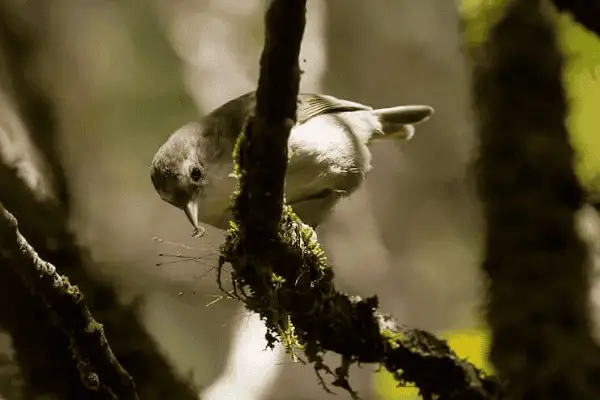
Identifying Features and Nesting Habits
The akikiki breeds from March to June. They build their nests high in ohia trees with bark, moss, and plant fibers. Each nest usually has one to two eggs. Their unique way of nesting and living in the Hawaiian forest makes them interesting to watch.
Conservation Efforts and Where to Find
The Akikiki is facing many threats like disease and habitat loss. Conservation efforts are underway to save this critically endangered Hawaiian bird. You can find them in the Alakai Wilderness Preserve on Kauai, above 4,000 feet. Bird lovers might be able to see this rare bird in its natural home.
“Two-thirds of Hawaiian native avian diversity — 95 species — has disappeared since human settlement of the islands 1,600 or more years ago.”
Only 17 of the original 55 Hawaiian honeycreepers are left today. The akikiki shows why it’s vital to protect these rare birds and their homes. Conservation work, like restoring habitats and controlling predators, is key to saving this critically endangered hawaiian bird.
4. Akohekohe
- Scientific name – Palmeria dolei
- Lifespan – 9 years (maximum recorded)
- Size – (17 to 18 cm)
- Weight – Unknown
- Wingspan – Unknown
If you love birds and are exploring Maui’s green landscapes, watch for the akohekohe finch. It’s a rare bird found only in Maui. This bird stands out with its black feathers and bright colors like white, gray, yellow, silver, and orange.
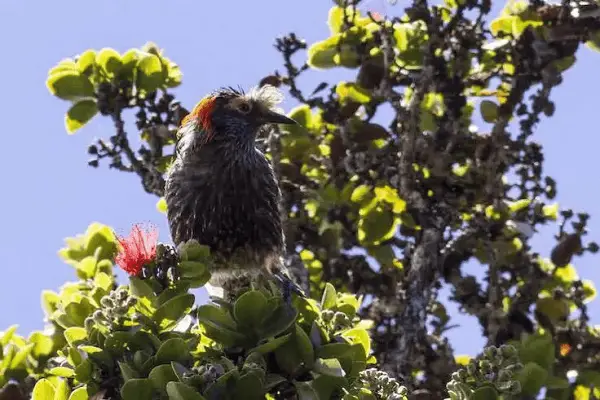
The akohekohe finch catches your eye with its orange eye-ring and a bright orange patch on its neck. Its big, white crest is what makes it stand out. This crest gives the akohekohe a royal look, making it a sight to see.
Being a Maui endemic bird, the akohekohe has a special way of making sounds. It whistles, gurgles, and buzzes in the Ohia forests it lives in. These birds make their nests high up in Ohia trees, laying one or two eggs at a time.
The akohekohe’s main food is nectar, with some insects as a bonus. This makes them known as “nectar sippers.” They carefully take nectar from flowers.
Unfortunately, the akohekohe finch is in danger, with only about 2,500 left. Habitat loss, predators, and diseases threaten this beautiful bird. Conservation efforts are trying to save this maui endemic bird for the future.
“The akohekohe finch is a true jewel of Maui’s avian diversity, a vibrant reminder of the island’s unique and fragile ecosystem.”
For bird lovers or nature fans, seeing the akohekohe finch in the wild is unforgettable. Its unique look and behavior make it a must-see in Maui’s forests.
5. Ananias
- Scientific name – Magumma parva
- Lifespan – 9 years (maximum recorded)
- Size (average) – (10 cm)
- Weight – (9 to 10 g)
- Wingspan – Unknown
In Kauai’s lush, mountainous forests, the Anianiau shines as a vibrant, vulnerable honeycreeper. Its bright yellow male and soft yellowish-green female forms delight birdwatchers and nature lovers. This bird is a true gem of the island.
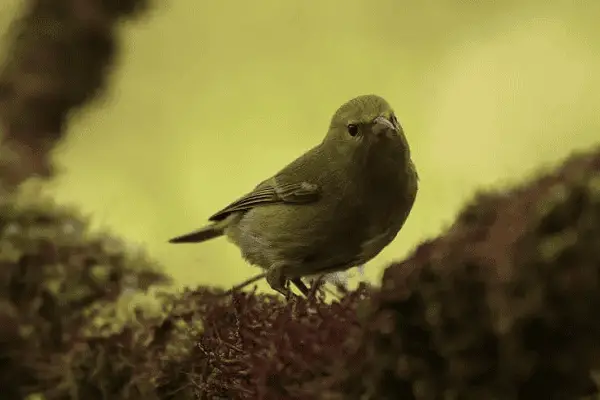
Description and Breeding Season
The Anianiau’s cheerful trill and sweet “su-weet” call make it stand out in Hawaii’s bird world. These small birds build cup-shaped nests and breed from February to June. They lay up to three eggs at a time. Their breeding matches the Ohia tree’s bloom, a key food source for them and other Hawaiian honeycreepers.
Habitat and Population Status
The Anianiau lives in Kauai’s remote, high forests. It thrives among Ohia, Koa, Olapa, and Lapalapa trees, often above 2,000 feet. Koke’e State Park and the Alakai Wilderness Preserve are great places to see them.
Though listed as vulnerable, the Anianiau’s numbers are stable, with about 8,700 birds. Yet, their territory has shrunk by 85% over time. These finches of Hawaii face threats from habitat loss, disease, invasive species, and predators. It’s vital to protect Kauai’s native birds, like the Anianiau, to save our unique natural heritage.
| Anianiau Fact | Details |
|---|---|
| Habitat | Remote, high-elevation forests of Kauai, dominated by Ohia, Koa, Olapa, and Lapalapa trees |
| Population Trend | Stable, with an estimated 8,700 individuals |
| Threats | Habitat destruction, disease, competition with introduced species, and predation |
“Protecting Kauai’s native birds, including the Anianiau, is crucial to preserving the island’s unique and irreplaceable natural heritage.”
6. Apapane
- Scientific name – Himatione sanguinea
- Lifespan – 11 years (maximum recorded)
- Size (average) – (13 cm)
- Weight – (14.4 to 16 g)
- Wingspan – Unknown
The apapane finch is the most common finch in Hawaii. It lives on the islands of Hawaii, Kauai, Oahu, and Maui. Both males and females have a bright red color with black wings and legs. They also have a black upper tail and a white rump. Their song, “dee-der-di-di-di,” is a joy to hear.
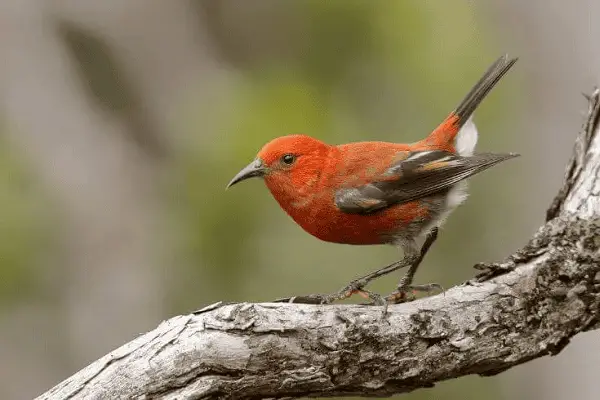
Apapane finches of Hawaii live in native forests with ‘ōhi’a trees, usually above 4,100 feet. This is to avoid mosquitoes that carry diseases. They build their nests in ‘ōhi’a trees. These nests can hold up to three eggs, laid from January to March.
They mainly eat nectar but also insects like butterflies and moths. This shows their diverse diet.
Even though the apapane finch is not threatened, it faces many dangers. These include losing its habitat, being eaten by other animals, getting diseases, and competing with non-native birds. To protect them, we need to create nature reserves and stop the spread of a deadly fungal disease.
| Characteristic | Description |
|---|---|
| Plumage | Vibrant crimson color with black wings, black upper tail, black legs, and white rump |
| Size | Females typically range from 14.4g (0.51oz) to 16g (0.56oz) for males |
| Diet | Primarily nectar, but also consume butterflies, moths, hoppers, lacewing larvae, and spiders |
| Breeding | Breeding season starts between October and November, with a peak between February and June |
| Habitat | Native mesic and wet forests with ‘ōhi’a trees, often above 4,100 feet elevation |
| Population | Estimated at more than 1.5 million individuals, with the largest populations on Hawaii and Maui Islands |
| Threats | Habitat loss, disease, and non-native species like mongooses, rats, and feral cats |
The apapane finch, the most common hawaiian finch, is a vibrant and beloved species. It plays a key role in Hawaii’s ecosystem. We need to protect their homes and stop diseases to help them survive.
7. Hawaii Akepa
- Scientific name – Loxops coccineus
- Lifespan – 10 years (maximum recorded)
- Size – (10 to 13 cm)
- Weight – (10 to 12 g)
- Wingspan – (6 to 7 cm)
The Hawaii Akepa is a rare bird found only in Hawaii. It’s a delight for bird lovers, with its bright colors and unique beak. But, it’s in danger, and we need to act to save it.

Appearance and Feeding Habits
The male Hawaii Akepa shines in orange color, while females wear a greenish-gray coat with a yellow band on their chest. They both have a special pale, crossed beak for eating insects and caterpillars. Their trilling song and a faint “middle-ee” call help them talk to each other in the forest.
Distribution and Threats
Today, the Hawaii Akepa lives only in Hawaii, gone from Oahu and Maui. With only 14,000 individuals left, it’s sadly endangered. Threats like habitat loss, disease, and new diseases are pushing it toward extinction.
We’re working hard to save the Hawaii Akepa. This includes making protected forests and starting reforestation programs. But, we must keep up the effort to make sure it doesn’t disappear forever.
8. Hawaii Amakihi
- Scientific name – Chlorodrepanis virens
- Lifespan – 12 years (maximum recorded)
- Size (average) – (11 cm)
- Weight – (10 to 16 g)
- Wingspan – Unknown
The Hawaii Amakihi is a true survivor among Hawaii’s native finches. It thrives where many others struggle. With its versatile diet and wide habitat range, the Hawaiian amakihi finch is a standout adaptable Hawaiian bird.
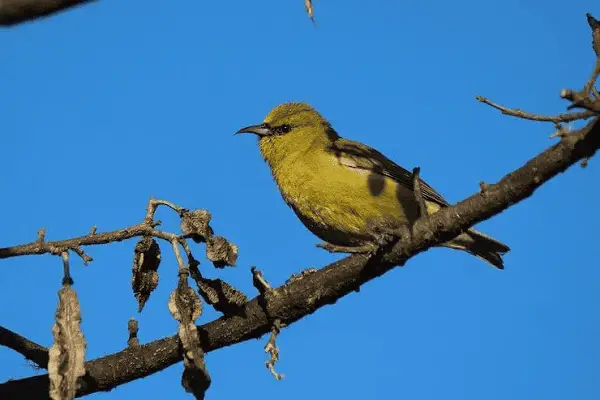
The male Amakihi has a bright yellow-green or olive body and a black curved beak. It also has a light-colored face and black spots near its eyes. Females look similar but their feathers are less bright. They make a beautiful trilling song and a “chee” call.
These finches of Hawaii build nests with twigs, grass, and leaves. The female lays two to three eggs. They eat insects, nectar, and fruit, making them fit in many environments.
“The Hawaii Amakihi is a true success story among Hawaii’s endangered birds. Its ability to adapt to changing conditions has allowed it to maintain a healthy population, even as many of its fellow honeycreepers face an uncertain future.”
While other Hawaiian finches face threats like habitat loss and disease, the Hawaiian amakihi finch stays strong. Its widespread across the islands shows its amazing adaptability and survival skills.
9. Hawaii Creeper
- Scientific name – Loxops mana
- Lifespan – Unknown
- Size – (11 to 13 cm)
- Weight – (13 to 15 g)
- Wingspan – Unknown
The Hawaii creeper is a special bird known for its unique way of finding food. It lives in Hawaii’s native forests. It uses its sharp beak to find insects and spiders in tree bark.
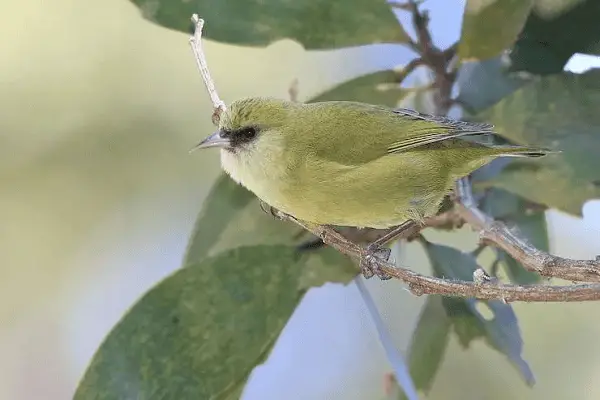
Plumage and Vocalizations
The Hawaii creeper looks grayish-olive on top and white underneath. This color helps it hide among tree trunks. It sings a trilling song and makes a soft “tiddle-ee” sound. These sounds help birdwatchers find it.
Nesting and Best Places to See
The Hawaii creeper builds its nest in ‘Ōhi’a and Koa trees. These trees provide perfect shelters in the forest. The Hakalau Forest National Wildlife Refuge is a great place to see the Hawaii creeper.
If you’re visiting the Hawaiian islands and love birdwatching, check out the protected forests. You might see the Hawaii creeper up close.
“Observing the Hawaii Creeper in its natural habitat can be a rewarding experience for birdwatchers visiting the Hawaiian islands.”
10. Iiwi
- Scientific name – Drepanis coccinea
- Lifespan – Unknown
- Size (average) – (14 cm)
- Weight – (16 to 19 g)
- Wingspan – Unknown
The Iiwi, also known as the scarlet honeycreeper, is a stunning bird from the Hawaiian Islands. It’s famous for its bright scarlet feathers, black wings, and long, curved bill. This bill helps it eat the nectar from Hawaiian flowers. The Iiwi shows how unique and diverse the birds of this island are.
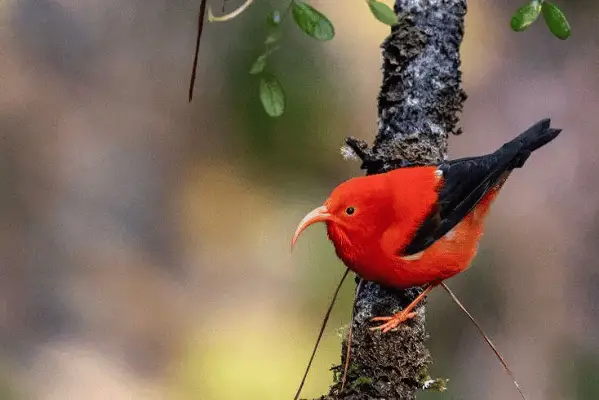
But, the Iiwi is in danger. Over 90% of where it used to live is gone, and it’s now listed as vulnerable. Avian malaria and the loss of its ʻŌhiʻa tree home threaten it. The Rapid ʻŌhiʻa Death disease is also a big problem.
There are efforts to save the Iiwi and other Hawaiian honeycreepers. Projects to fight mosquitoes and control rats offer hope. Protecting native forests is also key, as the Iiwi needs the ʻŌhiʻa trees to survive.
If you visit the Hawaiian Islands, look out for the Iiwi. It’s a symbol of these islands. With more conservation, we can keep this amazing bird flying in Hawaii for years to come.
“The ʻIʻiwi, or scarlet honeycreeper, is classified as vulnerable by the IUCN. Over 90% of the ʻIʻiwi’s range has been lost.”
The Iiwi, or scarlet honeycreeper, is a remarkable bird in the Hawaiian Islands. Here are some key facts about this iconic species:
- The Iiwi was once one of the most common birds in Hawaii, but now its population is limited to just three islands.
- Approximately 600,000 Iiwi birds are estimated to be left in the wild.
- The Iiwi’s peak breeding season is from February to June, with the female laying two to four eggs and incubating them for 14 days.
- Juvenile Iiwi molt into their iconic bright scarlet-and-black adult plumage.
- Introduced mammals like cats, rats, mongooses, and feral pigs have adversely impacted the Iiwi and other Hawaiian forest birds.
Despite the challenges, conservation efforts are in place to protect the Iiwi and its home. With dedication and action, we can help this species and preserve Hawaiian biodiversity.
Check Our Previous Articles:
Other Rare and Endemic Finches
Hawaii is home to many rare and endemic honeycreepers, like the Kauai Amakihi, Laysan Finch, Nihoa Finch, Maui Parrotbill, and Palila. These birds face threats like habitat loss, invasive species, and disease. They need conservation efforts to survive.
11. Kauai Amakihi
- Scientific name – Chlorodrepanis stejnegeri
- Lifespan – 9 years (maximum recorded)
- Size (average) – (11 cm)
- Weight (average) – (17 g)
- Wingspan – Unknown
The Kauai Amakihi lives only on Kauai. It’s a rare and endemic honeycreeper. Threats include habitat loss, non-native predators, and diseases. Conservation is working to save this bird.
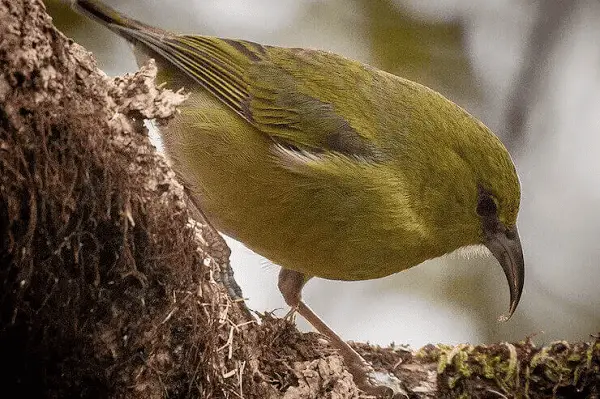
Frequently Asked Questions
Q1. What kind of finches are in Hawaii?
Hawaii is home to various native finches, particularly Hawaiian Honeycreepers, which evolved from finch-like ancestors. Examples include the ‘I‘iwi, ‘Apapane, and Palila.
Q2. How did the finch get to Hawaii?
Finches likely arrived in Hawaii millions of years ago from Asia or North America, possibly blown off course by storms, and then evolved into the unique honeycreeper species found today.
Q3. What bird is Hawaii known for?
Hawaii is known for the Nēnē, also known as the Hawaiian Goose, which is the state bird.
Q4. What is the rarest bird in the world in Hawaii?
The rarest bird in Hawaii is the ‘Alalā, or Hawaiian Crow, which is critically endangered and survives mainly in captivity with ongoing efforts to reintroduce it into the wild.





